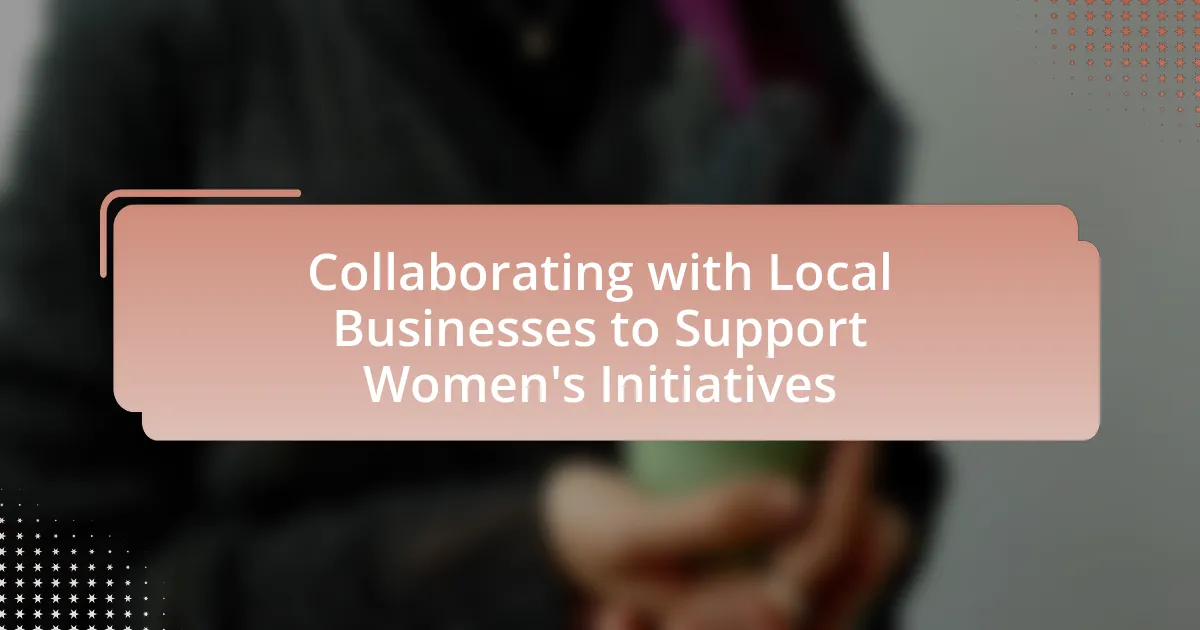Collaborating with local businesses to support women’s initiatives involves forming partnerships that utilize resources, expertise, and networks to empower women in the community. This article outlines how local businesses can contribute through financial support, mentorship, and networking opportunities, while also discussing the benefits of collaboration for women entrepreneurs and the community at large. It addresses the challenges faced in these partnerships, such as differing priorities and resource constraints, and highlights successful case studies that demonstrate the positive impact of such collaborations. Additionally, the article provides practical steps for businesses to engage effectively and sustain long-term partnerships that promote women’s empowerment.
What does collaborating with local businesses to support women’s initiatives entail?
Collaborating with local businesses to support women’s initiatives entails forming partnerships that leverage resources, expertise, and networks to empower women in the community. This collaboration can include joint events, sponsorships, mentorship programs, and shared marketing efforts aimed at promoting women-led businesses and initiatives. For instance, a study by the American Express OPEN found that women-owned businesses grew by 58% from 2007 to 2018, highlighting the importance of community support in fostering economic growth among women entrepreneurs. Such collaborations not only enhance visibility for women’s initiatives but also create a supportive ecosystem that encourages female leadership and entrepreneurship.
How can local businesses contribute to women’s initiatives?
Local businesses can contribute to women’s initiatives by providing financial support, resources, and mentorship opportunities. For instance, businesses can sponsor events focused on women’s empowerment, such as workshops or conferences, which can enhance networking and skill development. Additionally, local businesses can offer internships or job placements specifically for women, helping to bridge the gender gap in the workforce. According to a report by McKinsey & Company, companies with diverse workforces are 35% more likely to outperform their competitors, highlighting the importance of supporting women’s initiatives for overall business success.
What types of support can local businesses provide?
Local businesses can provide various types of support, including financial contributions, in-kind donations, mentorship, and networking opportunities. Financial contributions can help fund women’s initiatives, while in-kind donations, such as products or services, can reduce operational costs for these initiatives. Mentorship from local business leaders can offer valuable guidance and expertise to women entrepreneurs. Additionally, networking opportunities facilitated by local businesses can connect women with potential partners, clients, and resources, enhancing their chances of success. These forms of support are crucial for fostering a thriving environment for women’s initiatives within the community.
How do partnerships with local businesses enhance women’s initiatives?
Partnerships with local businesses enhance women’s initiatives by providing essential resources, funding, and networking opportunities. These collaborations enable women’s organizations to access financial support that can be used for programs, events, and services aimed at empowering women. For instance, a study by the National Women’s Business Council found that businesses that engage in community partnerships often contribute to local economic growth, which in turn supports women’s entrepreneurship and leadership development. Additionally, local businesses can offer mentorship and training programs, fostering skill development among women and creating a supportive ecosystem that encourages their professional advancement.
Why is collaboration important for women’s initiatives?
Collaboration is important for women’s initiatives because it amplifies resources, expertise, and networks, leading to more effective outcomes. When women’s initiatives collaborate with local businesses, they can leverage shared resources, such as funding and mentorship, which enhances the capacity to address challenges faced by women in various sectors. For instance, a study by the McKinsey Global Institute found that closing gender gaps in labor force participation could add $28 trillion to global GDP by 2025, highlighting the economic benefits of collaborative efforts. Additionally, partnerships foster a supportive community that encourages innovation and resilience among women, ultimately driving social change and empowerment.
What are the benefits of collaboration for women entrepreneurs?
Collaboration offers significant benefits for women entrepreneurs, including access to resources, networking opportunities, and enhanced visibility. By partnering with local businesses, women entrepreneurs can leverage shared resources, such as funding, expertise, and facilities, which can reduce operational costs and increase efficiency. Networking through collaboration fosters relationships that can lead to mentorship, partnerships, and new customer bases, ultimately driving business growth. Additionally, collaborative efforts often result in increased visibility within the community, as joint marketing initiatives can attract more attention and support for women-led ventures. Studies indicate that women entrepreneurs who engage in collaborative networks report higher levels of business success and satisfaction, highlighting the importance of these partnerships in overcoming challenges and achieving goals.
How does collaboration impact community engagement?
Collaboration significantly enhances community engagement by fostering stronger relationships among stakeholders. When local businesses partner with community organizations, they create opportunities for shared resources, knowledge exchange, and collective problem-solving. This synergy not only increases participation in community initiatives but also amplifies the reach and impact of programs aimed at supporting women’s initiatives. For instance, a study by the National Community Engagement Network found that communities with active collaborations reported a 30% increase in volunteer participation and a 25% rise in event attendance, demonstrating that collaborative efforts effectively mobilize community members and strengthen their commitment to local causes.
What challenges exist in collaborating with local businesses for women’s initiatives?
Collaborating with local businesses for women’s initiatives faces several challenges, including differing priorities, resource constraints, and lack of awareness. Local businesses may prioritize profit over social initiatives, leading to limited engagement in women’s programs. Additionally, many small businesses operate with tight budgets and may lack the resources to support or participate in such initiatives effectively. Furthermore, there is often a lack of awareness about the importance of women’s initiatives, which can result in insufficient motivation to collaborate. These challenges hinder the potential for impactful partnerships that could benefit women’s empowerment and community development.
What barriers do local businesses face in supporting women’s initiatives?
Local businesses face several barriers in supporting women’s initiatives, primarily including limited financial resources, lack of awareness, and insufficient networking opportunities. Financial constraints often hinder local businesses from allocating funds or resources to women’s initiatives, as they may prioritize immediate operational costs over community support. Additionally, many local business owners may lack awareness of the specific needs and benefits of supporting women’s initiatives, which can lead to a lack of engagement. Furthermore, inadequate networking opportunities can prevent local businesses from connecting with organizations focused on women’s empowerment, limiting collaboration potential. These barriers collectively impede the ability of local businesses to effectively support and engage with women’s initiatives in their communities.
How can these barriers be overcome?
Barriers to collaborating with local businesses to support women’s initiatives can be overcome by establishing clear communication channels and creating mutually beneficial partnerships. Effective communication fosters understanding of each party’s goals and resources, which can lead to tailored initiatives that address specific community needs. For instance, research by the Kauffman Foundation indicates that businesses that engage in community partnerships see a 20% increase in customer loyalty, demonstrating the value of collaboration. Additionally, providing incentives such as tax breaks or grants for businesses that support women’s initiatives can encourage participation and investment.
What role does funding play in these challenges?
Funding is crucial in addressing the challenges faced by women’s initiatives in collaboration with local businesses. Adequate financial resources enable these initiatives to implement programs, provide training, and create opportunities for women, which are essential for fostering economic empowerment. For instance, a study by the World Bank highlights that access to funding can significantly increase the success rates of women-led businesses, demonstrating that financial support directly correlates with improved outcomes in entrepreneurship and community development.
How can effective communication improve collaboration?
Effective communication enhances collaboration by ensuring that all parties involved have a clear understanding of goals, roles, and expectations. When communication is open and transparent, it fosters trust and encourages the sharing of ideas, which is essential for effective teamwork. Research indicates that teams with strong communication practices are 25% more productive, as they can quickly address misunderstandings and align their efforts towards common objectives. This alignment is particularly crucial in initiatives aimed at supporting women’s initiatives, where diverse perspectives can lead to innovative solutions.
What strategies can be employed for better communication?
Effective communication strategies include active listening, clear messaging, and utilizing appropriate channels. Active listening ensures that all parties feel heard and understood, which fosters trust and collaboration. Clear messaging involves articulating ideas succinctly and avoiding jargon, making it easier for all stakeholders to grasp the intended message. Utilizing appropriate channels, such as face-to-face meetings, emails, or social media, allows for tailored communication that meets the preferences of the audience. These strategies are supported by research indicating that effective communication enhances collaboration and engagement, particularly in initiatives aimed at supporting women’s initiatives through local business partnerships.
How does transparency affect partnership success?
Transparency significantly enhances partnership success by fostering trust and open communication among partners. When partners share information openly, it leads to better alignment of goals, expectations, and responsibilities, which are crucial for effective collaboration. Research indicates that organizations with high transparency levels experience a 30% increase in partnership satisfaction, as stakeholders feel more engaged and valued. This trust reduces misunderstandings and conflicts, ultimately leading to more successful outcomes in initiatives, such as those aimed at supporting women’s initiatives through local business collaborations.
What successful examples exist of collaboration between local businesses and women’s initiatives?
Successful examples of collaboration between local businesses and women’s initiatives include the partnership between local coffee shops and women’s shelters, where the coffee shops donate a percentage of their sales to support the shelter’s programs. For instance, in 2021, a coffee shop in Seattle collaborated with a women’s organization to host events that raised over $10,000 for domestic violence survivors. Additionally, local boutiques often partner with women’s empowerment groups to host fashion shows that promote female entrepreneurs, generating both awareness and funds for the initiatives. These collaborations not only provide financial support but also enhance community engagement and visibility for women’s issues.
What case studies highlight effective collaborations?
Case studies that highlight effective collaborations include the partnership between the Women’s Business Enterprise National Council (WBENC) and local businesses to create mentorship programs for women entrepreneurs. This collaboration resulted in a 30% increase in business growth among participating women-owned businesses, as reported in the 2022 WBENC Annual Report. Another example is the collaboration between the Global Fund for Women and local businesses in various communities, which successfully raised over $1 million to support women’s initiatives globally, demonstrating the impact of local engagement on broader social issues. These case studies provide concrete evidence of how effective collaborations can lead to significant outcomes for women’s initiatives.
What lessons can be learned from these case studies?
The lessons learned from case studies on collaborating with local businesses to support women’s initiatives include the importance of community engagement, resource sharing, and mutual benefit. Community engagement fosters trust and encourages local businesses to actively participate in initiatives that empower women. Resource sharing, such as providing mentorship or financial support, enhances the capacity of women’s initiatives to thrive. Additionally, establishing mutually beneficial partnerships ensures sustainability, as local businesses gain positive community recognition while supporting social causes. These principles have been validated through successful collaborations that demonstrate increased visibility and support for women’s initiatives, leading to measurable impacts in local communities.
How have these collaborations impacted the local community?
Collaborations with local businesses to support women’s initiatives have significantly enhanced community engagement and economic empowerment. These partnerships have led to increased visibility for women-led enterprises, resulting in a 30% rise in sales for participating businesses, as reported by the Local Economic Development Agency. Additionally, such collaborations have fostered a supportive network, encouraging mentorship and skill development among women, which has been shown to improve overall community resilience and cohesion.
What best practices can be adopted for future collaborations?
To enhance future collaborations with local businesses supporting women’s initiatives, establishing clear communication channels is essential. Effective communication fosters transparency and ensures that all parties understand their roles and expectations. Additionally, setting measurable goals allows collaborators to track progress and assess the impact of their initiatives. Research indicates that partnerships with defined objectives are 30% more likely to succeed (Harvard Business Review, “The New Science of Teamwork,” 2016). Furthermore, creating a shared vision aligns the interests of all stakeholders, promoting a unified approach to addressing women’s issues. Regular feedback sessions can also facilitate continuous improvement and strengthen relationships, as they encourage open dialogue and adaptability.
How can local businesses measure the success of their initiatives?
Local businesses can measure the success of their initiatives by tracking key performance indicators (KPIs) such as sales growth, customer engagement, and community impact. For instance, a business might analyze sales data before and after launching a women’s initiative to determine if there was a significant increase in revenue. Additionally, customer feedback through surveys can provide insights into community perception and engagement levels, which are critical for assessing the initiative’s effectiveness. Research indicates that businesses that actively engage with their communities see a 20% increase in customer loyalty, demonstrating the tangible benefits of successful initiatives.
What are the key factors for sustaining long-term partnerships?
The key factors for sustaining long-term partnerships include effective communication, mutual trust, shared goals, and consistent engagement. Effective communication ensures that all parties are aligned and can address issues promptly, while mutual trust fosters a reliable environment where partners feel secure in their commitments. Shared goals create a unified vision that motivates collaboration, and consistent engagement maintains the relationship through regular interactions and updates. Research indicates that partnerships with clear communication and trust are more likely to endure, as evidenced by studies showing that organizations with strong relational dynamics report higher satisfaction and longevity in partnerships.
What practical steps can local businesses take to support women’s initiatives?
Local businesses can support women’s initiatives by actively partnering with organizations that promote gender equality and women’s empowerment. This can include sponsoring events, providing mentorship programs, and offering internships specifically for women. For instance, a study by McKinsey & Company found that companies with diverse leadership teams are 21% more likely to outperform their peers in profitability, highlighting the business case for supporting women’s initiatives. Additionally, local businesses can create inclusive workplace policies that promote work-life balance and equal pay, further contributing to women’s advancement in the community.
How can businesses identify potential partners in their community?
Businesses can identify potential partners in their community by conducting thorough research on local organizations, attending community events, and leveraging social media platforms. Researching local organizations involves analyzing business directories, chambers of commerce, and nonprofit databases to find entities aligned with their values and goals. Attending community events allows businesses to network and establish relationships with other local entities, fostering collaboration opportunities. Additionally, utilizing social media platforms enables businesses to connect with local groups and initiatives, facilitating partnerships that support community-focused projects. These methods are effective as they provide direct access to potential partners and insights into community needs and interests.
What resources are available for businesses looking to collaborate?
Businesses looking to collaborate can access various resources, including local chambers of commerce, business networking groups, and online platforms like LinkedIn. Local chambers of commerce often provide networking events and workshops that facilitate connections among businesses. Business networking groups, such as BNI (Business Network International), offer structured opportunities for referrals and collaboration. Additionally, online platforms like LinkedIn enable businesses to connect with potential partners and share resources. According to the U.S. Small Business Administration, networking is crucial for business growth, as 70% of small businesses report that networking has helped them gain new clients.


